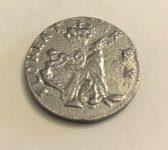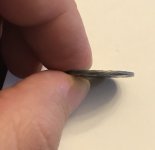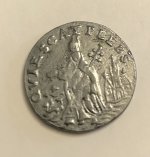Lawmans.Collectibles
Newbie
- May 3, 2018
- 1
- 0
- Primary Interest:
- All Treasure Hunting
This wasn't a metal detecting find, but part of a lot I recently acquired. I purchased a box of Older World Coins, which included some late 1880s-1920s French, Canadian, British, etc. coins. At the bottom of the container was an envelope with three coins in it, none of which I had ever seen before. I have identified 2 of the 3 as genuine Ancient Roman Coins (One Bronze Galerius from 305-311 AD and the other a silver medieval Venice coin). The third coin is what appears to be a St. Patrick Farthing. I need help identifying whether it is genuine or a copy. I'm not convinced it's genuine, however, it does not have a seam on the edge like most copies do and it appears to be made of pewter or some other like metal. It is darker in color and is NOT magnetic. However, the picture looks a little grainy and there is only a very faint trace of the reeded edge.
Appreciate all input! Many thanks from a new member.



Appreciate all input! Many thanks from a new member.






